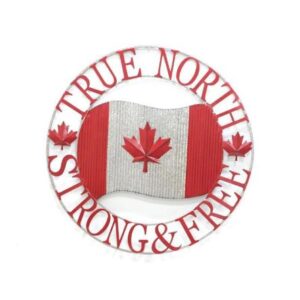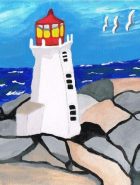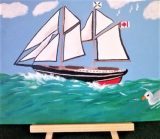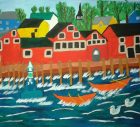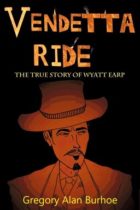The Canadian Mounties Ride West!
Canadian Mounties. The Story of the North-West Mounted Police is an epic one.
And it led to one of the worldwide iconic Cultural Heroes of the 20th Century — The Mythic Mountie.

🍁 Visions of the Canadian Mounted Police. Fort Whoop-Up, Five Thousand Outlaws and the Mounties’ Great March West…
Canadian Mounties: What’s in a name?
A Brief History Note. It was 1867. The Americans purchased Alaska from the Russian Empire. Prime Minister John A MacDonald led the Confederation of our brand new Dominion of Canada.
Shortly after, MacDonald was given alarming news about the Canadian West. Rupert’s Land was falling into a state of chaos. Rupert’s Land was an area as big as Europe, soon to be renamed the Canadian North-West Territories.
Before Confederation, a small number of red-coated soldiers of the British Army patrolled Rupert’s Land. Keeping peace and good relations with the Native Peoples on behalf of “The Grandmother” (Queen Victoria). Two years after Confederation, those soldiers were recalled to England.
By 1870, First Nations tribes were being devastated by a Smallpox epidemic. Every village, every tipi, echoed with their death songs as the people suffered fever, delirium and death. Père Albert Lacombe, a beloved priest of the Oblat de Marie-Immaculée in Winnipeg, reported on the source of the virulent Smallpox. It had originated with wagonloads of infected blankets from the U.S. military infirmary of St. Louis. Which the First Nations people had found abandoned on the open plains.
Then the ravening whiskey traders came. “Flogging their teams north with loads of ‘Injun whiskey’ to finish the job of destroying a race which their pestilence had started.” [1]
The Frontier traffickers pushed into the limitless unprotected “Indian country.” Building fortified trading posts. And offering guns and potent “rotgut” trade whiskey in return for furs, buffalo robes and horses from an already anguished, desperate native people.
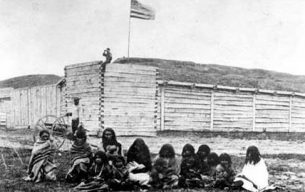
Fort Whoop-Up, Canadian North-West Territories, 1873
The biggest post was Fort Whoop-Up. A place of “drunken debauchery, fraud and cruelty.” [1]
And a place of ever-present violence: “Hundreds of Blackfoot Indians died as a result of the whisky trade. Either killed in drunken quarrels, shot by whisky traders, frozen to death while drunk. Or poisoned by the whisky itself. Chiefs lost their authority. Their people traded everything they owned. And entire communities were decimated.” [2]
Originally called Fort Hamilton (after its owner, Montana businessman Alfred Baker Hamilton), its wild occupants quickly renamed it Fort Whoop-Up.
Other whiskey posts were also re-christened. Fort Stand-Off earned its name in 1872 when its men successfully stood off a posse, led by Deputy US Marshall Charles Hard, that had followed their supply wagon train from Fort Benton, Montana Territory.
Fort Solomon was named for its manager, Mose Solomon. It was renamed when its traders, hearing that some Blood Indians had killed the teamster bringing them supplies from Fort Benton, ordered “All Blood Injuns better slide out of here!” It was renamed Fort Slide-Out.
And the remorseless whiskey traders prospered.
Blackfoot Chief Crowfoot would later say, “Bad men and whisky were killing us so fast that very few of us would have been left today.”
Both Père Lacombe and Methodist missionary Rev George MacDougall made trips to Ottawa. They pleaded with the MacDonald government to halt the devastating whiskey trade. They were ignored.
And then…
Cypress Hills, June 1, 1873.
The Cypress Hills Massacre. A ragtag group of Wolfers, Fur Trappers and Buffalo Hunters calling themselves the “Spitzee Cavalry” attacked a band of sleeping Woody Mountain Assiniboines. Heavily armed with Henry repeating rifles and two Smith & Wesson’s large revolvers each, the group “wiped out the forty lodges, very few escaping.” They left the encampment with two wagonloads of buffalo hides and furs, a rich take. Ten days later, the Helena Daily Herald out of Montana would publish the story that would shake the newborn Dominion, “Whites on the War Path: Forty Lodges Wiped out by Sixteen Kit Carsons.” [3]
News of the atrocity reached the East. The Catholic Church and Protestant newspapers hotly demanded that MacDonald finally do something.
MacDonald announced that he was going to create a Canadian Field Force. An armed, self-reliant mounted company to be sent west to establish law and justice.
President Ulysses S Grant warned MacDonald not to send that military field force west. Doing so would be considered an Act of War against the USA. This was the time of Manifest Destiny. In the mid-1860’s, U.S. Secretary of State William H Seward was then bargaining for the acquisition of Alaska from the Russian Empire. And Seward had spoken publicly about “next annexing British North American territories.” American trading posts in the Canadian northwest, including the ruthless outposts Fort Whoop-Up, Fort Spitzee, Fort Kipp, Fort Stand-Off and Fort Slide-Out, were already flying the Stars and Stripes.
Prime Minister MacDonald took the Act to Create a Canadian Field Force out of his desk.
MacDonald dipped pen into inkwell, scratched out some words and neatly wrote: “North-West Mounted Police.” The name change, he explained in Parliament, reflected the non-military goals of the new force. Adding that a company of “fewer than 300 brave men” was no danger to our neighbour to the south. “They are to be purely a civil, not a military body. With as little gold lace, fuss, and fine feathers as possible. Not a crack cavalry regiment, but an efficient police force for the rough and ready — particularly ready — enforcement of law and justice.” The new force’s motto was “Maintiens Le Droit” — “Maintain The Right.” [4]
President Grant read his ambassador’s report from Canada. Then the old soldier looked at the map of U.S. and Canadian western territories. He knew that he had already sent 2000 additional soldiers — infantry and cavalry — just to counter the “Sioux problem.” And that he had 12,000 more troops throughout the western frontier. Hell, George Custer alone had over 600 battle-hardened men in his command. Twice the number of this green Canadian force.
The U.S. Marshall William Fletcher Wheeler Report…
U.S. Marshal William Wheeler, based in Helena, Montana Territory, had reported to Washington that “over 5000 American toughs and outlaws” were hiding across the Canadian Line. And there were thousands of native Blackfoot, Blood, Cree and Assiniboines just as hostile as the Cheyenne and Sioux.
Grant lit up a stogie and watched the rolling smoke thoughtfully. This Canadian Field Force, or whatever MacDonald was calling it now, had to ride a thousand miles just to get to the Canadian West. And then fight for control of a wild lawless territory bigger than Alaska. “Fewer than 300 men,” he concluded. “Let them go. They will never make it.”
“The Great March West.”
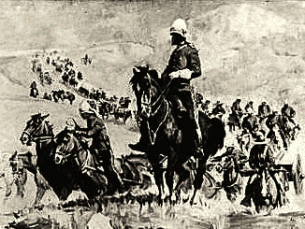
NWMP Great March West of 1874
The North-West Mounted Police (NWMP) began their historic Great March West to establish the Queen’s Law on July 8, 1874.
They had enough horses for the 275 policemen as well as their Métis scouts and teamsters. They took 73 wagons full of supplies. And two nine pounder cannons, weighing a ton-and-a-half each. The Mounties trained those cannons on the treacherous Fort Whoop-Up on October 9th…
When the Mounted Police moved on to their second objective, Fort Spitzee, they found that the “Spitzee Cavalry” had already abandoned it. And hastily retreated south. The police commandeered the intact fort, making it the first NWMP outpost. [5]
With winter due, the main force moved on to the south bank of the Oldman River. Where they built Fort Macleod, their headquarters. They then built Fort Walsh and Fort Calgary.
Our Canadian Mounties had arrived.
In 1904, their heroic achievements received recognition when King Edward VII granted the Force the prefix “Royal.” And it became the Royal North-West Mounted Police (RNWMP).
In February 1920, the Mounted Police were amalgamated with the Ottawa-based Dominion Police, which had carried out federal policing and security in eastern Canada. They were given their modern name, Royal Canadian Mounted Police (RCMP).
“The Rough and Ready Enforcement of Law and Justice.”
Although initially created to shut down the pernicious whiskey forts and establish Canadian Sovereignty in its own Western Territories, our Canadian Mounties soon found themselves expanding their job description…
Hunting down the remaining “toughs and outlaws” who hadn’t already fled back over the border. Patrolling that border to keep out other “questionable ruffians,” including whisky smugglers. Watching for known members of the Spitzee Cavalry, should they be caught on Canadian soil — the charges were murder, rape and theft. Setting up customs posts. Negotiating treaties with the Native Peoples. Protecting the dwindling bison population from foreign hunters, thus saving the bison from extinction. Fighting miles-wide prairie grass fires that mysteriously burst out just inside the Canadian Border. And policing the homesteaders, ranchers and merchants who followed the arrival of the “Scarlet Riders.”
The more success the Canadian Mounties achieved, the more they were needed.
How did 275 men accomplish so much in such an immense perilous territory? They were welcomed (and protected) by the chiefs of the Blackfoot Confederacy. Given sage advice by Père Lacombe, “Peacemaker of the Northwest.” Able to hire astute scouts and interpreters such as Scotch-Cree Jerry Potts, Métis Jean Baptiste Morin, Métis Baptiste Page, Scotch-Métis Norbert Welsh, Blood Tribe Kukatosi-Poka (Starchild), Métis Louis Laronde, Blackfoot Sisomm (Dog Child) and Blood Chief Joe Bull Shields.
And many Mounted Police officers proved to be men of foremost honesty. After all, the officer cadre consisted of hand-picked decorated veterans of the British Army, Royal Marines and Canadian Militia. They brought that Victorian Age sense of honour, valour and chivalry with them. Such as Superintendent James Macleod, who earned the trust and respect of the Native chiefs, calling Macleod “Stamixotokon” (“Bull’s Head,” from the bison head on the NWMP crest).
The Canadian Mounties embodied their founding principle of Maintaining the Right. [6]
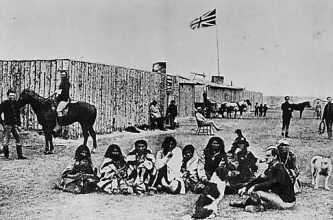
North-West Mounted Police Fort Calgary. Built 1875, Photo taken 1878.
And in so doing, our Canadian Mounties became our National Heroes.
“Live Free, Mon Ami!” – Brian Alan Burhoe
DEDICATION: In Memory of Constable Phil Callan, RCMP, Regimental #34615. A Good Man. A Friend.
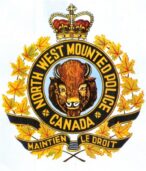
Canadian Mounties Quotes:
“I demand that neither hardship, suffering, privation, nor fear of death should move you by a hair’s breadth from carrying out your duties.” Lieutenant-Colonel George Arthur French, organizer and first Commissioner of the North-West Mounted Police.
“Bad medicine. Many ghosts.” Jerry Potts, Mounted Police scout, when first asked about Fort Whoop-Up.
“Let this be fair warning! From this day on, I’m the law out here. And I’ll arrest anyone I even think is trading whisky. I’ve got the authority to try any man and with a wink from Ottawa — I’ll hang him!” Superintendent James Macleod, NWMP, upon entering Fort Whoop-Up, October 9th, 1874.
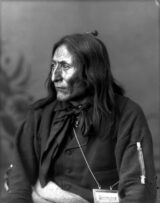
“Blackfoot Chief Crowfoot” Isapo-muxika
“If the Mounted Police had not come to the country, where would we all be now? Bad men and whisky were killing us so fast that very few of us would have been left today…
“The Mounted Police have protected us as the feathers of the bird protect it from the frosts of winter. I wish them all good. And trust that all our hearts will increase in goodness from this time forward…
“I am satisfied. I will sign the treaty.” Isapo-muxika (Crowfoot), Siksika chief of the Blackfoot Confederacy, upon signing Treaty 7, 1877.
Three Years Ago when the Mounted Police first came…
“Three years ago, when the Mounted Police first came to the country, I met and shook hands with Stamixotokon at the Mokowan River. Since that time he made me many promises. He kept them all. Not one of them was ever broken. Everything that the police have done has been good. I entirely trust Stamixotokon, and will leave everything up to him. I will sign with Crowfoot.” Mi’k ai’stoowa (Red Crow), Head Chief of the Kainai (Blood Indians).
“The grass in Canada is not stained with blood.” Tatanka-Iyotanka (Sitting Bull) to Inspector James Walsh of the North-West Mounted Police, when the Hunkpapa Sioux leader sought the protection of the Mounties for his people after the Battle of Little Bighorn.
Canadian Mounties Fiction:
“I know the history of the early North-West Mounted as much as any man alive. And I have always been impressed by the very human qualities of the men. By their trials, their shortcomings and the truly magnificent things they did as plain humans.” American author William Byron Mowery, one of the 10 Greatest Writers of Mountie Fiction.
From their beginning, fictional stories have been told of our Mounties….
YOU’VE GOT TO SEE “THE WRITERS OF THE NORTH-WEST MOUNTED POLICE” — MY MOST POPULAR LITERARY HISTORY POST:
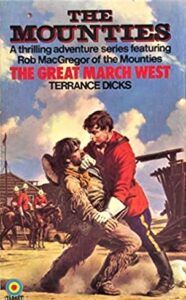 “No other nation owes its primary Mythology to such a mix of international writers! Four Americans, three Canadians, an Australian, an Englishman and a Norwegian. The Aussie and Norwegian served as Mounties.” Brian Alan Burhoe
“No other nation owes its primary Mythology to such a mix of international writers! Four Americans, three Canadians, an Australian, an Englishman and a Norwegian. The Aussie and Norwegian served as Mounties.” Brian Alan Burhoe
“Thanks for a wonderful in-depth article on Mountie fiction. I’m a big fan of the Mounties and I really enjoyed the amount of details you provided and found many, many more books to put on my wish list.” Jack Wagner, Creator of Mon Legionnaire
“I just discovered your blog and need to dig deeper into it. I’m all for anything that increases people’s knowledge about these older, mostly forgotten authors. That post on Mountie fiction is great!” Western writer James Reasoner
A sweeping survey of the writers who created the magnificent Mythology of our North-West Mounted Police. My Top 10 Mountie Fiction Writers in some detail. And a look at many other authors. Including Giles A Lutz and Terrance Dicks, who both wrote about the taking of Fort Whoop-Up. Amply illustrated with marvelous magazine and book covers. FREE TO READ ==> The GREATEST AUTHORS OF NORTH-WEST MOUNTED POLICE FICTION
A Shout-out to Hollywood…
A heart-felt shout-out to those esteemed Hollywood screenwriters Burt Kennedy, Gil Doud, Frank Gruber, George Wallace Sayre, Frank Fenton and Cecil B DeMille. All of whom inspired my love of history and true national mythology, and showed me how to craft it. God Bless ’em! If you haven’t met all of them, just Google each name with “Mounties” after it. — Brian Alan Burhoe
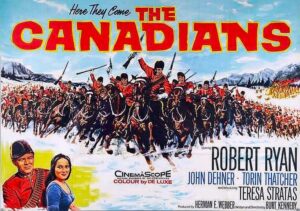
Canadian Mounties Informing Footnotes:
[1] The quotes “Flogging their teams north with loads of ‘Injun whiskey’…” and “drunken debauchery, fraud and cruelty” are from STRANGE EMPIRE. The dramatic and eloquent book by noted Montana journalist, historian, and author Joseph Kinsey Howard.
[2] “Hundreds of Blackfoot Indians died as a result of the whisky trade…” Hugh Aylmer Dempsey. Author of CROWFOOT: Chief of the Blackfeet, University of Oklahoma Press, Norman, Oklahoma, 1972. And FIREWATER: The Impact of the Whisky Trade on the Blackfoot Nation, Fifth House Publishers, Markham, Ontario, 2002.
[3] “Whites on the Warpath: Forty Lodges Wiped out by Sixteen Kit Carsons.”
No official death toll of the Cypress Hills Massacre — men, women and children — was ever issued. Numbers from 20 to 400 have been quoted.
The Helena newspaper gave this account, based on the eyewitness report of two participants:
“It was determined to attack this encampment of Assiniboines. And to do it on the Indian plan. Accordingly, at the first break of day the next morning, the sixteen or seventeen whites attacked and effectually wiped out the forty lodges, very few escaping. Two of the men loaded two wagons with robes and furs and started for Benton. The two men reached Benton on Saturday last, from whose statements these particulars were gleaned…
“Only one white man was killed, and he was shot through the heart by a wounded Indian whom he pursued into the brush. The name of the man killed is Ed Grace, a man well known by the people of Helena and Prickly Pear Valley.”
– Helena Daily Herald, June 11, 1873.
But time changes opinions…
“Most old-timers who were in the territory of Montana in the early seventies, are still able to recall the Cypress Hills Massacre. It’s declared by witnesses to be one of the bloodiest and most revolting crimes against the red man in the annals of the West. And an occurrence which caused an almost strained feeling between the Canadian Government, within whose domain the incident happened, and the Montana Territorial government.”
– Hill County Democrat (Havre, Montana), August 20, 1926.
[4] Q. “What’s the myth about Mounties always getting their man?”
The Mounties’ official motto translates as “Maintain The Right” or “Uphold the Right.” But in Hollywood’s Canada it became common to hear dialogue like, “You know our motto. Get Your Man!”
It’s an American idea. And was based on fact. It first appeared in a Montana newspaper report:
“Fort McLeod, N.W.T., March 20, 1877. Thanks to the vigilance of Major Irvine and the energy of Captain Winder, of the N.W. Mounted Police, another attempt to smuggle whiskey into the Indian country has been frustrated by the arrest of three men. They were tried, found guilty and sentenced to pay a fine of five hundred dollars each or be imprisoned for the minor period of six months. They preferred the former. Horses were sacrificed for the arrest, but the Mounted Police are worse than bloodhounds when they scent the track of a smuggler. And they fetch their men every time.”
– Fort Benton Record, Friday, April 13, 1877.
Although the amazing success our Canadian Mounties had in tracking down criminal suspects was due in large part to their Métis and First Nations Mounted Police scouts. After all, those scouts were highly motivated to hunt down “bad white men.”
Their real-life success would inspire the noble image of the Mythic Mountie…
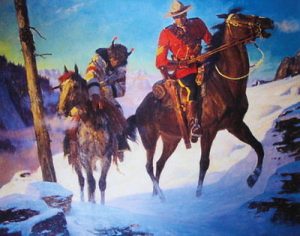
Other Captured Forts…
[5] Fort Kipp (built by Joseph Raven Quiver Kipp), on the Oldman River, and Fort Stand-Off, on the Belly (Mokowan) River, were both taken over by the Canadian Mounties until Fort Macleod was completed. After the North-West Rebellion, Fort Kipp was renovated and served for years as a Mounted Police patrol post.
I’m told that Fort Slide-Out, farther along the Belly, was also abandoned but presented a mystery. Three new gun carriages without barrels were found in a storehouse. As well as a pile of pine-board signs — one freshly painted “Remember the Al.”
To learn more, see the Complete List of Alberta’s Trading, Military & Mounted Police Forts: North American Forts – Alberta, Canada. Compiled by Pete Payette 0f the American Forts Network.
CANADIAN MOUNTIES Creation & History Royal Mounted Police
[6] A Concluding Brief History Note: By the time John A MacDonald’s “fewer than 300 brave men” had established their first Police Posts, the MacDonald Conservative government had fallen. It was the new Liberal Prime Minister Alexander Mackenzie who created and passed the Indian Act. This included the establishing of Residential Schools. And it was PM Alexander Mackenzie who refused to keep many of the Mounties’ promises to the First Nations. Promises that had been authorized by MacDonald before the Mounties even headed West.
When Mackenzie mentioned that he might accept President Grant’s new offer to deploy US troops to join the North-West Mounted Police in Western Canada, Lord Dufferin, our Governor General representing Queen Victoria, firmly talked him out of it.
The Grant Connection: “The Peace Policy.”
President Grant’s 1869 Peace Policy (“Kill the Indian, Save the Man”) included Boarding Schools as part of his plan to “civilize” American Indian children. Prime Minister Alexander Mackenzie’s Indian Act followed Ulysses S Grant’s Peace Policy almost word for word, or at least idea for idea.
As of men faithful and honourable…
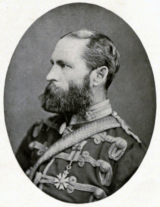
Commissioner James Macleod “Stamixotokon”
George Arthur French (who was the NWMP’s first Commissioner), James Macleod (the Mounties’ second Commissioner, called Stamixotokon by the First Nations) and Inspector James Morrow Walsh (who had granted Sitting Bull and over 5000 Sioux refuge in Canada) would each, in his turn, resign his commission in the NWMP.
Each one because of Government broken promises to the First Nations and Métis People.
Three Men of Honour.
Canadian Mounties — Further Reading:
NATION MAKER: Sir John A. Macdonald, Volume Two (1867-1891) by Richard Gwyn
OPENING UP THE WEST: Being the Official Reports to Parliament of the Activities of the North-West Mounted Police Force from 1874-1881 by the Commissioners of the NWMP
STRANGE EMPIRE: A Narrative of the Northwest by Joseph Kinsey Howard (Reprinted in Canada as STRANGE EMPIRE: The Story of Louis Riel)
BEAR CHILD: The Life and Times of Jerry Potts by Rodger D Touchie
FATHER LACOMBE: The Black-Robe Voyageur by Katherine Hughes
THE MARCHING CALL by Harwood Steele
THE GREAT ADVENTURE: Selections from the Diaries, Letters & First-Hand Accounts of the Original NWMP. Collected by David Cruise & Alison Griffiths
Canadian Mounties: Creation & History of the Royal Mounted Police – Whiskey Forts – RCMP News.
Note on Images: Both “Mythic Mountie” oil on canvas paintings on this page are by American artist Arnold Friberg (1913-2010). See Art Country Canada. Other artwork, historic photos and book covers are in the public domain.
Updated Canada Day, July 1, 2023. Celebrating our Canadian Mounties on their RCMP 150th Anniversary.
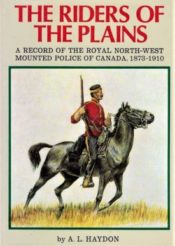 Canadian Mounted Police. Fort Whoop-Up, Five Thousand Outlaws and the Great March West. Why were the northwest mounted police created? Who created the Indian Act?
Canadian Mounted Police. Fort Whoop-Up, Five Thousand Outlaws and the Great March West. Why were the northwest mounted police created? Who created the Indian Act?
Burt Kennedy, Canadian Mounted Police, Canadian Mounties, Fort Slide-Out, Frank Gruber. Mountie fiction, Mounties Canada, RCMP Canada, Royal Mounted Police, U S Marshal Charles Hard, Get Your Man, Kucka-toosinah.
American Indians, annex Canada. Illicit whisky, Native American village, Sioux Chief, Whisky Forts.
